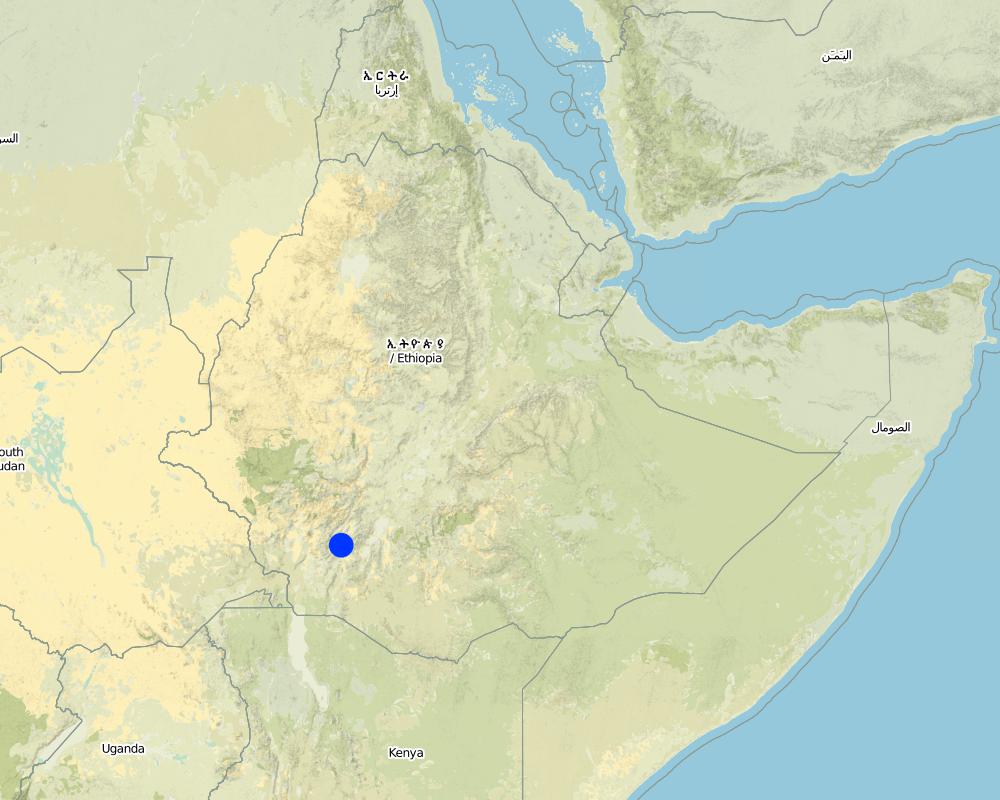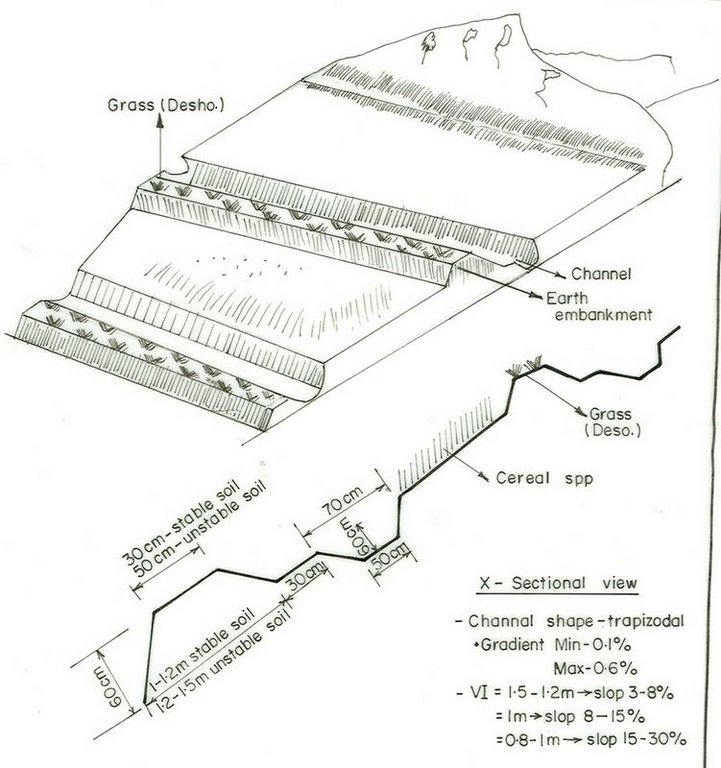Boreda Soil Bund [埃塞俄比亚]
- 创建:
- 更新:
- 编制者: Unknown User
- 编辑者: –
- 审查者: Fabian Ottiger, Alexandra Gavilano
technologies_1415 - 埃塞俄比亚
查看章节
全部展开 全部收起1. 一般信息
1.2 参与该技术评估和文件编制的资源人员和机构的联系方式
关键资源人
SLM专业人员:
Mesfin Melaku
Gam Gofa Zone Rural Development Main Department
埃塞俄比亚
有助于对技术进行记录/评估的机构名称(如相关)
Gamo Gofa Zone Rural Development Department - 埃塞俄比亚1.3 关于使用通过WOCAT记录的数据的条件
编制者和关键资源人员接受有关使用通过WOCAT记录数据的条件。:
是
2. SLM技术的说明
2.1 技术简介
技术定义:
Structure constructed by digging a shallow channel on the upper hill side and putting the excavated soil on the down side to build the embankment
2.2 技术的详细说明
说明:
A structure constructed across the slope along the contour with earth. The embankment is stablized with grasses which is planted during rainy season. Construction is made in groups or by individual farmer, with or without incentives.
Purpose of the Technology: It reduces soil erosion, drain excess runoff during heavy storm which would cause over flow on the land and reduce runoff velocity. Grasses planted on the enbankment for stabilization can solve the animal feed and also soil deposited behind the bund can improve the fertility status of the soil.
Establishment / maintenance activities and inputs: Bunds are continuously repaired during and after heavy storm especially in the first two years after construction. Grasses and tree plant species are planted on the enbankment in order to stablize the structure. Cut and curry and cntroled grazing is common on the embankment.
Natural / human environment: Reduce soil erosion, enhance vegetation growth, improve the beauty of the land scape
2.5 已应用该技术的、本评估所涵盖的国家/地区/地点
国家:
埃塞俄比亚
区域/州/省:
SNNPR
有关地点的进一步说明:
Boreda
具体说明该技术的分布:
- 均匀地分布在一个区域
如果不知道精确的区域,请注明大致覆盖的区域:
- 10-100 平方千米
注释:
Total area covered by the SLM Technology is 18.29 km2.
scattered SWC activities wrere made in all peasent associations but the above mentioned peasent associations are the dominant once
Map
×2.6 实施日期
如果不知道确切的年份,请说明大概的日期:
- 不到10年前(最近)
2.7 技术介绍
详细说明该技术是如何引入的:
- 通过项目/外部干预
3. SLM技术的分类
3.2 应用该技术的当前土地利用类型

农田
- 一年一作
- 多年一作(非木材)
年作 - 具体指明作物:
- 谷类 - 大麦
- 根/块茎作物 - 红薯、山药、芋头/椰子,其他
- wheat
- Enset, Desho grass
每年的生长季节数:
- 2
具体说明:
Longest growing period in days: 180Longest growing period from month to month: Jun - JanSecond longest growing period in days: 120Second longest growing period from month to month: Mar - May
注释:
Major land use problems (compiler’s opinion): cost of fertilizer, shortage of farm land and grazing land, cultivation of steep slopes
Major land use problems (land users’ perception): cost of fertilizer, shortage of farm land and low productivity
3.4 供水
该技术所应用土地的供水:
- 雨养
3.5 该技术所属的SLM组
- 横坡措施
3.6 包含该技术的可持续土地管理措施

植物措施

结构措施
- S2:堤、岸
注释:
Secondary measures: vegetative measures
Type of vegetative measures: aligned: -contour
3.7 该技术强调的主要土地退化类型

土壤水蚀
- Wt:表土流失/地表侵蚀
- Wg:冲沟侵蚀/沟蚀

化学性土壤退化
- Cn:肥力下降和有机质含量下降(非侵蚀所致)
注释:
Main type of degradation addressed: Wt: loss of topsoil / surface erosion
Secondary types of degradation addressed: Wg: gully erosion / gullying, Cn: fertility decline and reduced organic matter content
3.8 防止、减少或恢复土地退化
具体数量名该技术与土地退化有关的目标:
- 减少土地退化
4. 技术规范、实施活动、投入和成本
4.1 该技术的技术图纸
技术规范(与技术图纸相关):
SNNPR
Technical knowledge required for field staff / advisors: high
Technical knowledge required for land users: high
Main technical functions: reduction of slope angle
Secondary technical functions: control of concentrated runoff: retain / trap, reduction of slope length, increase in soil fertility
Aligned: -contour
Vegetative material: G : grass
Grass species: Desho (it is local grass)
Slope (which determines the spacing indicated above): 19.00%
If the original slope has changed as a result of the Technology, the slope today is (see figure below): 9.00%
Gradient along the rows / strips: 0.00%
Bund/ bank: level
Vertical interval between structures (m): 0.8
Spacing between structures (m): 15
Depth of ditches/pits/dams (m): 0.5
Width of ditches/pits/dams (m): 0.6
Length of ditches/pits/dams (m): 62
Height of bunds/banks/others (m): 0.6
Width of bunds/banks/others (m): 0.5
Length of bunds/banks/others (m): 62
Bund/ bank: graded
Vertical interval between structures (m): 1
Spacing between structures (m): 13
Depth of ditches/pits/dams (m): 0.6
Width of ditches/pits/dams (m): 0.7
Length of ditches/pits/dams (m): 58
Height of bunds/banks/others (m): 0.65
Width of bunds/banks/others (m): 0.5
Length of bunds/banks/others (m): 60
Structural measure: bund/ bank: level
Vertical interval between structures (m): 1
Spacing between structures (m): 13
Depth of ditches/pits/dams (m): 0.6
Width of ditches/pits/dams (m): 0.7
Length of ditches/pits/dams (m): 58
Height of bunds/banks/others (m): 0.65
Width of bunds/banks/others (m): 0.5
Length of bunds/banks/others (m): 60
Construction material (earth): soils excavated from the ditch is used to build the enbankment
Slope (which determines the spacing indicated above): 15%
If the original slope has changed as a result of the Technology, the slope today is: 5%
Lateral gradient along the structure: 0%
For water harvesting: the ratio between the area where the harvested water is applied and the total area from which water is collected is: 1:11
Vegetation is used for stabilisation of structures.
4.2 有关投入和成本计算的一般信息
其它/国家货币(具体说明):
Birr
如相关,注明美元与当地货币的汇率(例如1美元=79.9巴西雷亚尔):1美元=:
8.5
注明雇用劳工的每日平均工资成本:
0.70
4.3 技术建立活动
| 活动 | 时间(季度) | |
|---|---|---|
| 1. | raising seedlings and collecting grass | onset of rain season |
| 2. | transplanting | rain season |
| 3. | weeding | at the end of rain season |
| 4. | Surveying | dry season |
| 5. | digging of channel | dry season |
| 6. | build trapezoidal enbankment | dry season |
| 7. | stabilize with grasses | rain season |
4.4 技术建立所需要的费用和投入
| 对投入进行具体说明 | 单位 | 数量 | 单位成本 | 每项投入的总成本 | 土地使用者承担的成本% | |
|---|---|---|---|---|---|---|
| 劳动力 | Labour | ha | 1.0 | 52.5 | 52.5 | |
| 设备 | Machine use | ha | 1.0 | 15.0 | 15.0 | 100.0 |
| 植物材料 | Grass | ha | 1.0 | 20.0 | 20.0 | |
| 技术建立所需总成本 | 87.5 | |||||
| 技术建立总成本,美元 | 10.29 | |||||
注释:
Duration of establishment phase: 12 month(s)
4.5 维护/经常性活动
| 活动 | 时间/频率 | |
|---|---|---|
| 1. | replanting | |
| 2. | removal of deposited soils from the ditches | dry season/annual |
4.6 维护/经常性活动所需要的费用和投入(每年)
| 对投入进行具体说明 | 单位 | 数量 | 单位成本 | 每项投入的总成本 | 土地使用者承担的成本% | |
|---|---|---|---|---|---|---|
| 劳动力 | Replanting and removal of deposited soils from the ditches | ha | 1.0 | 4.38 | 4.38 | |
| 技术维护所需总成本 | 4.38 | |||||
| 技术维护总成本,美元 | 0.52 | |||||
注释:
the culculation is based on the length of the structures per hectar of land
4.7 影响成本的最重要因素
描述影响成本的最决定性因素:
slope
5. 自然和人文环境
5.1 气候
年降雨量
- < 250毫米
- 251-500毫米
- 501-750毫米
- 751-1,000毫米
- 1,001-1,500毫米
- 1,501-2,000毫米
- 2,001-3,000毫米
- 3,001-4,000毫米
- > 4,000毫米
指定年平均降雨量(若已知),单位为mm:
1800.00
农业气候带
- 潮湿的
- 半湿润
5.2 地形
平均坡度:
- 水平(0-2%)
- 缓降(3-5%)
- 平缓(6-10%)
- 滚坡(11-15%)
- 崎岖(16-30%)
- 陡峭(31-60%)
- 非常陡峭(>60%)
地形:
- 高原/平原
- 山脊
- 山坡
- 山地斜坡
- 麓坡
- 谷底
垂直分布带:
- 0-100 m a.s.l.
- 101-500 m a.s.l.
- 501-1,000 m a.s.l.
- 1,001-1,500 m a.s.l.
- 1,501-2,000 m a.s.l.
- 2,001-2,500 m a.s.l.
- 2,501-3,000 m a.s.l.
- 3,001-4,000 m a.s.l.
- > 4,000 m a.s.l.
关于地形的注释和进一步规范:
Landforms: Hill slopes. Also ridges and plateau/plains
Slopes on average: Hilly. Also moderate and rolling
5.3 土壤
平均土层深度:
- 非常浅(0-20厘米)
- 浅(21-50厘米)
- 中等深度(51-80厘米)
- 深(81-120厘米)
- 非常深(> 120厘米)
土壤质地(表土):
- 中粒(壤土、粉土)
- 细粒/重质(粘土)
表土有机质:
- 中(1-3%)
- 低(<1%)
如有可能,附上完整的土壤描述或具体说明可用的信息,例如土壤类型、土壤酸碱度、阳离子交换能力、氮、盐度等。:
Soil fertility is low-medium
Soil drainage/infiltration is medium-poor
Soil water storage capacity is medium-high
5.6 应用该技术的土地使用者的特征
生产系统的市场定位:
- 生计(自给)
- 混合(生计/商业)
非农收入:
- 低于全部收入的10%
相对财富水平:
- 贫瘠
- 平均水平
机械化水平:
- 手工作业
- 畜力牵引
说明土地使用者的其他有关特征:
Population density: 50-100 persons/km2
Annual population growth: 1% - 2%
1% of the land users are rich and own 3% of the land.
39% of the land users are average wealthy and own 72% of the land.
60% of the land users are poor and own 25% of the land.
Level of mechanization: Manual labour (hand tools) and animal traction (oxen)
5.7 应用该技术的土地使用者使用的平均土地面积
- < 0.5 公顷
- 0.5-1 公顷
- 1-2 公顷
- 2-5公顷
- 5-15公顷
- 15-50公顷
- 50-100公顷
- 100-500公顷
- 500-1,000公顷
- 1,000-10,000公顷
- > 10,000公顷
6. 影响和结论性说明
6.1 该技术的现场影响
社会经济效应
生产
作物生产
饲料生产
饲料质量
生产区域
土地管理
收入和成本
工作量
社会文化影响
SLM/土地退化知识
生态影响
水循环/径流
地表径流
SLM之前的数量:
69
SLM之后的数量:
45
多余水的排放
土壤
土壤流失
SLM之前的数量:
4.9
SLM之后的数量:
4
其它生态影响
Soil fertility
Waterlogging
6.2 该技术的场外影响已经显现
下游洪水
下游淤积
6.4 成本效益分析
技术收益与技术建立成本相比如何(从土地使用者的角度看)?
短期回报:
积极
长期回报:
非常积极
技术收益与技术维护成本/经常性成本相比如何(从土地使用者的角度看)?
短期回报:
中性/平衡
长期回报:
稍微积极
6.5 技术采用
注释:
62% of land user families have adopted the Technology with external material support
1367 land user families have adopted the Technology with external material support
Comments on acceptance with external material support: estimates
30% of land user families have adopted the Technology without any external material support
721 land user families have adopted the Technology without any external material support
Comments on spontaneous adoption: estimates
There is a little trend towards spontaneous adoption of the Technology
Comments on adoption trend: the posetive results of the conserved land attracts some the farmes to applythe technique by themselves without and external support
6.7 该技术的优点/长处/机会
| 土地使用者眼中的长处/优势/机会 |
|---|
|
erosion and runoff control How can they be sustained / enhanced? maintenance every cropping season |
| 编制者或其他关键资源人员认为的长处/优势/机会 |
|---|
|
Reduce soil erosion and concentrated runoff How can they be sustained / enhanced? frequent maintaince |
|
Water harvesting and increase infiltration of the soil How can they be sustained / enhanced? Improve access to marketing of valuable crops |
|
Grasses and fodder plant species have solved the problem for animal feed How can they be sustained / enhanced? plant improved fodder species |
6.8 技术的弱点/缺点/风险及其克服方法
| 土地使用者认为的弱点/缺点/风险 | 如何克服它们? |
|---|---|
| more labour required | form development commettee with working groups |
| 编制者或其他关键资源人员认为的弱点/缺点/风险 | 如何克服它们? |
|---|---|
| occupied cultivated lands | increase the productivity of land per unit area |
链接和模块
全部展开 全部收起链接
无链接
模块
无模块



